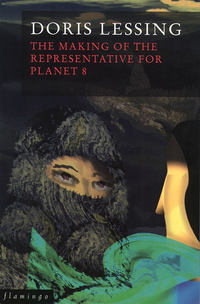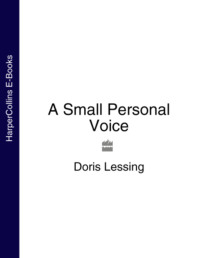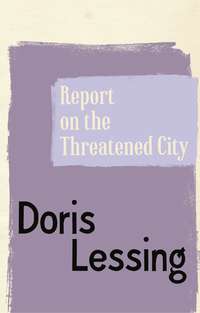
Полная версия
Shikasta
Hunting has ceased to be the main source of food. Agriculture is well developed, with grains of all sorts, gourds, leafy plants. Husbandry is practised, with a good developing relation with the animal stocks. There is as yet no urgent need for irrigation: natural water patterns remain adequate. But the Giants’ research suggests that irrigation should be established in the hotter areas of the Central part.
Our report is one of success.
It is this mission’s opinion that conditions are ripe for the establishment of the Lock. The Giants are anxious for this. Without in any way complaining or wishing to hasten phases which should not be hastened, they feel excluded from the common contacts of the galaxy. While none of them, as an individual, remembers genuine contact – the free flow of thought, ideas, information, growth between planet and planet across our galaxy – it is not long since the oldest of the Colony 10 immigrants died, and, in any case, their genetic memory is strong, active, developing. And all their preparations for the establishment of the Lock are made.
A WARNING
There are persistent rumours – mostly formalized as tales and songs told by the Natives, who get news very fast as their groups meet in the course of hunting or other expeditions – that ‘down South’ there are races of extremely warlike and hostile beings. The Giants have sent expeditions to the two main landmasses, and have found only that the species established by Sirius are flourishing. (These will be the subject of a subreport.) It is clear to us that the Sirian tutors have caused these rumours to spread, so as to prevent our experimentees from wandering over into their territory. The Giants, who understood this, have created new legends and stories, and are doing everything to create mental sets that will keep our bargain with Sirius.
Nothing of this is more than was to be expected, but there is something else. There are persistent rumours about ‘spies’, both among the Natives and among the Giants. These spies do not enter Giant territory, but appear quite frequently among the Natives, and everywhere over the northern hemisphere. At first the Giants believed these to be from Sirian colonies, on ordinary fact-finding missions, but they now believe there are also spies from some other empire. They are cautious about committing themselves, but repeat that the distinguishing feature of these creatures is not in appearance, but in behaviour. In short, they showed every feature of the Degenerative Disease. In our view everything we have heard can only confirm the presence of Shammat.
OUR CONCLUSIONS
1 The Lock may begin. We have optimum conditions.
2 It should not be forgotten in our plans that this planet is subject to sudden and drastic change.
3 Inquiries should be made from Sirius if spies from Shammat have been found in their territories.
4 Attention should be directed to what Shammat is likely to be wanting. On the face of it there is no place for Shammat on this planet.
Shortly after that the Lock was established, and was a success, making missions and special envoys unnecessary. The minds of the Giants – or to put it more accurately, factually, the Giant-mind – had become one with the mind of the Canopean System, at first partially, and tentatively, but it was an ever-growing and sensitizing current. What came through from Rohanda was all good news. To absorb the tapes and records from that period of nearly ten thousand years is to participate in achievement, success, development. Few of our colonies have fulfilled our plans so hearteningly. The ‘spies’ of the mission’s report mentioned above seemed to fade out of the picture. It was assumed on Canopus that they were destroyed by the suddenness of the Lock – that they had not been able to stand the change to higher and finer vibrations, though we did not rule out the possibility that these creatures of Shammat had evolved, rather than died out, and possibly even in a way that might contribute to the general variety and richness of Rohanda.
We have to look at things now rather differently. In short, it is a question, if not of apportioning blame – never a very helpful process, tending always to draw the attention away from essentials, rather than focusing it – then of knowing what went wrong, so as to avoid it on other planets. But the main cause of the disaster was what that word dis-aster implies: a fault in the stars. That we could not foresee, beyond acknowledging that nothing on Rohanda could be taken for granted. If there had not been that shift in stellar alignments, it would not have mattered what the Shammat agents were doing, or plotting.
But how was it we did not know they were there?
The fault was partly ours – Canopus. As for Sirius, our relations continued to be formally correct: exchanges of information took place between the Colonial Services on the mother planets. At the local Rohandan or Shikastan level, they did not behave worse than we had expected, considering the much lower level of their Empire. But it is this lower level of the Sirian Empire which is the key to this and other problems of Rohanda/Shikasta; and my understanding of it is different now. It must be remembered that we servants of Canopus are also in the process of evolution, and our understandings of situations change as we do. [See History of the Sirian Empire.]
In short, we were not thinking much of Shammat at all. It is easy now to say we were mistaken. Puttiora itself was concerned, or so it seemed, to keep well out of our way: the alliance between the Empire of Sirius and the Canopean Empire was not to be taken lightly! Throughout our part of the galaxy there was peace, there was harmonious development, and no one challenged us. Why should they? Seldom has the galaxy seen such a blaze of accomplishment, such a long period without any war at all.
Perhaps it is the fault of the species who thrive in peace, mutual help, aspirations for more of the same – to forget that outside these borders dwell very different types of mind, feeding on different fuel. It is not that Canopus did not guard itself from the vile Puttiora emanations, that we did not keep ourselves informed about that revolting empire, which dismayed us more because it could only remind us of our earlier, less pleasant stages of development – it was not that we were negligent in that. But Puttiora did not challenge us anywhere else – so why on Rohanda?
And so we did not take Shammat enough into account. That Puttiora should allow an outpost on a planet all rock and desert had always seemed to us inexplicable, though the rumours did come that Shammat had been colonized by criminals fleeing from Puttiora, that Puttiora had ignored them until it was too late. We had no idea at all of how Shammat was sucking and draining sources of nourishment everywhere they could be found, of how it built itself up, a thief getting fat on its loot. When Shammat was already a successful pirate state, we still thought of it as a disgraceful but unimportant appendage to the terrible but fortunately far-distant Puttiora.
And what of the Giants, that alert, intelligent species who had everything on Rohanda under their control?
Again, we believe that this is a question of benign and nurturing minds not being able to credit the reality of types of mind keyed to theft and destruction. Colony 10 had never been anything but a place of fruitful cooperation, and as I have said, they are peculiarly well adapted to harmonious symbiosis with others. And on Rohanda they had not experienced setback and threat. We now believe it is a disadvantage to allow too much prosperity, ease of development – and on none of our other colonies have we again been satisfied with an easy triumphant growth. We have always inbuilt a certain amount of stress, of danger.
But suppose there had never been a disaster? Probably no one would ever have known that Shammat was on Rohanda … for Shammat can succeed only where there is disequilibrium, harm, dismay.
We had very little notice of the crisis. There was no reason to expect it. But the balances of Canopus and her System were suddenly not right. We had to find out what was wrong and very quickly. We did. It was Rohanda. She was out of phase, and rapidly worsening. The Lock was weakening. There were shifts in the balance of the forces from inside the body of Rohanda. These answered a shift – and now we had to look outwards, away from Rohanda – in the balances of powers elsewhere, among the stars who were holding us, Canopus, in a web of interacting currents with our colonized planets. Rohanda had felt the wrong alignment first, because it is her nature to be sensitive. Rohanda was at risk, Rohanda must be urgently rescued, held in phase, adjusted – so went our early thought.
But it was soon established that this could not be. Rohanda could not hold her place in our System. It was not so much a question of jettisoning her, as of her jettisoning herself.
Very well then: we could cushion and provide … so went our thought in that second stage of our discovery.
Rohanda was in for a long period – but at that stage we had no idea how very long it would be – of stagnation. But we would make sure that at least there would be no serious falling away from what she had accomplished, we would maintain her until the cosmic forces changed again, which they would do, so we had ascertained.
But then something else and worse was forced in on us. We could not make our information match with what we could register coming from Rohanda! The currents from Rohanda were coming wild, shrill, cracked … it was clear that they were being tapped. Previously, the strong full Lock between us and Rohanda had made impossible any such leeching away, but now there was no doubt of it.
Things started happening all at once. Information from Sirius about Puttiora, its sudden increase of strength and pride. Information from our spies in the Puttiora Empire – about Shammat, in particular. Shammat was like a drunk, shameless, boastful, reeling … Shammat was going from strength to strength. Shammat was taking advantage of the new weakness of Rohanda, who was unshielded, unguarded, open to her. Which meant that Shammat had been lying in wait on Rohanda, had been established there … had known what was going to happen? No, that was not possible; because with all our technology, so infinitely in advance of Shammat’s, we had not known.
It was not a question of Rohanda being nursed through a long quiescent period, but much worse.
An envoy would have to be sent, and at once.
And now I will describe Rohanda as I found it on my first visit.
But it was Shikasta now: Shikasta the hurt, the damaged, the wounded one. The name had already been changed.
Can I say that it is ‘with pleasure’ that I write of it? It is a retrospective emotion, going back before the bad news I carried. Rohanda had given us all so much satisfaction, it was our easiest and our best achievement. And don’t forget that it was Rohanda who was to take the place of that unfortunate planet who was so soon to be destroyed and who we were already emptying of its inhabitants, taking them to other places where they might thrive and grow.
What a crisis I left behind me on Canopus that time, what a roar of effort, change, and adjustment: plans cherished and relied on for millennia were being thrown over, adapted, substituted – and from this place of turmoil, I left for Shikasta, the stricken.
At least there is something of consolation that such excellence had been. What has been good is a promise that in other places, other times, good can develop again … at times of shame and destruction, we may sustain ourselves with these thoughts.
At the time of the disaster there were still not more than sixty thousand Giants, and about a million and a half Natives, distributed over the northern hemisphere. The planet was amazingly fruitful and pleasant. The waters that – released – would recreate the swamps and marshes were still locked up in ice at the poles, and we could see no reason why this should change.
There were great forests over all the northern and temperate zones and these were plentifully stocked with animals of all sorts, differing from those of my later visits mostly in size. These were not enemies of the inhabitants. There were settlements in the north, even in extremes of climate, both of Giants and Natives, but most of the population was settled further south, in the Middle Areas, where there was a sparkling, invigorating climate.
The cities were established where the patterns of stones had been set up according to the necessities of the plan, along the lines of force in the earth of that time. These patterns, lines, circles, arrangements were no different from those familiar to us on other planets, and were the basis and foundation of the transmitting systems of the Lock between Canopus and Rohanda … now poor Shikasta.
The arranging and alignment of the stones had been done initially entirely by the Giants, whose size and strength made the work easy for them, but by now the understanding between the Giants and the Natives was such that the Natives wished to assist in a task which they knew was – as they put it in their songs and tales and legends – their link with the Gods, with Divinity.
They did not see the Giants as Gods. They had developed beyond that. Their intelligence was so much greater, because of the Lock, that it was not far from that of the Giants just before the Lock.
The cities had been built on the lines indicated by the experiments that had been so extensive in the long preparatory phase before the Lock.
They were of stone, and were linked with the stone patterns as part of the transmitting system.
Cities, towns, settlements of mud, wood, or any vegetable material cannot disturb the transmitting processes, or set up unsuitable oscillations. It was for this reason that during the preparatory phase, the Giants discouraged stone as building material and themselves lived in houses of whichever organic substance was most convenient and to hand. Once the Lock was established, and the stone patterns set and operative, the cities were rebuilt of stone, and the Natives were instructed in this art – so soon to be lost to the memory of Shikasta – for the plan was that when the Natives had evolved to the adequate level, the Giants would leave for another task somewhere else, themselves evolved beyond anything that could have been envisaged by the handful from Colony 10 those many thousands of years ago.
What the Natives were being taught was the science of maintaining contact at all times with Canopus; of keeping contact with their Mother, their Maintainer, their Friend, and what they called God, the Divine. If they kept the stones aligned and moving as the forces moved and waxed and waned, and if the cities were kept up according to the laws of the Necessity, then they might expect – these little inhabitants of Rohanda who had been no more than scurrying monkeys, half in and half out of the trees, animals with little in them of the Canopean nature – these animals could expect to become men, would take charge of themselves and their world when the Giants left them, the work of the symbiosis complete.
The cities were all different, because of the different terrains on which they were established, and the currents and forces of those places. They might be on the open plains, or by springs, or by seashores, or on mountains or plateaux. They might be among snow and ice, or very hot, but each was exact and perfect and laid down according to the Necessity. Each was a mathematical symbol and shape, and mathematics were taught to the young ones by travel. A tutor would take a group of pupils to sojourn in, for instance, the Square City, where they would absorb by osmosis everything there is to be known about squareness. Or the Rhomboid, or the Triangle, and so on.
Of course, the shape of a city was as rigidly controlled upwards as it was in area, for roundness, or the hexagonal, or the spirit of Four, or Five, was expressed as much in the upper parts as it was by what was experienced where the patterns of stone in building enmeshed with the earth.
The flow of water around and inside a city was patterned according to the Necessity, and so was the placing of fire – as distinct from heat, which was done by steam and heated water – but fire itself, which the Natives could not rid themselves of thinking as Divine, was according to Need.
Each city, then, was a perfect artefact, with nothing in it uncontrolled: considered, with its inhabitants, as a functioning whole. For it was found that some temperaments would be best suited, and would contribute most, in a Round City, or a Triangle, and so on. And there had even evolved a science of being able to distinguish, in very early childhood, where an individual needed to live. And here was the source of that ‘unhappiness’ which must be the lot, to one extent or another, of every inhabitant of our galaxy, for it was by no means always so that every member of a family would be suitable for the same city. And even lovers – if I may use a word for a relationship which is not one present Shikastans would recognize – might find that they should part, and did so, for everybody accepted that their very existence depended on voluntary submission to the great Whole, and that this submission, this obedience, was not serfdom or slavery – states that had never existed on the planet, and which they knew nothing of – but the source of their health, and their future and their progress.
By now the two races lived together, there was no separation between them in that way, though they did not intermarry. This was physically not possible. The Giants had not grown more than was reported by the last mission: they were about eighteen feet in height. And the Natives were half that. But in the meantime, the Giants had become much varied in colour and in facial and bodily type. Some were as black, a glossy shining black, as the first immigrants. Others were all shades of lively warm brown. There were some with very pale faces, and their eyes were sometimes of a blue which when it first appeared caused unease and even abhorrence. The Natives were also of all shades of colour, and their head hair could be of any colour from black to chestnut. The Giants had evolved some head hair, probably from climatic pressure, but it was sparse, and short, contrasting with the Natives’ profuse locks. The blue-eyed Giants might have colourless, or light yellow hair, but this was considered a misfortune.
Sex had different intensities for the two races. The Giants, living four thousand or five thousand years, bred once, or twice, or not at all in a lifetime. (And carried their young for a long time, four or five years.) The female Giants, when not breeding or caring for children, did the same work as the males, and this was for most of their lives. The work was mostly mental, the continuous, devotional task of keeping the proper levels of transmission between the planet and Canopus. Sex with the Giants was not a strong drive as the Natives would understand it. The powers of sex, the attractions, the repulsions, the ebbs and flows, were transmuted into higher forces except when actually in use for propagation.
The Natives were being encouraged to breed. They lived now for about a thousand years, but the planet could sustain, with ease, a larger population. It was never envisaged that there would be more than about twenty million, building up slowly over the next few thousand years: nothing had ever been planned in the nature of a sudden increase. There would be a careful, controlled building of new, well-sited cities, and there was no shortage of places suitable for the Necessity. Natives who chose to, and were considered suitable by general consent, might have several progeny in the first hundred years of their lives. After that, while sex continued as a pleasure and a balancing force, the breeding mechanisms became inoperative, and they entered a long, energetic, vigorous middle age. The Degenerative Disease, as we define it, did not yet exist; degenerative diseases of the physical sort that later were common had not come into existence. Both Giants and Natives died of accidents, of course, but otherwise not unless through the very rare invasions of viruses against which they had no defence. The breeding programmes were then adjusted as necessary.
I was sent to Rohanda by one of our fastest craft, and not by means of Zone Six. I did want to inspect Zone Six, but not until after I had studied the situation on the planet itself where I needed to be quickly, and in the flesh. It had been decided that I should be in the form of a Native and not of a Giant, because I was to stay on and help the Natives after the Giants had been taken off. This decision was correct. Others were arguable. Looking back, afterwards, I knew that I should have sacrificed other considerations to getting to my task more quickly. Yet I did need to acclimatize myself. I could not appear at once in any one of the cities, with its specialized vibrations, without suffering severe effects. The difference between Canopus and Rohanda was very great, and none of us could begin work at once on arrival: time had always to be given to the process of acclimatization. But things were worse that we had thought: and were worsening faster than expected.
The spaceship approached the extreme eastern edge of the main landmass from the northwest, coming low over fertile and forested mountains and plateaux and plains that later were great deserts – thousands of square miles of deserts. We saw several cities, and wondered how the inhabitants who chanced to look up thought of our crystalline sphere darting past, and how they would talk of it to those who hadn’t seen us.
At that time I did not know which city it would be best to approach first. On the extreme eastern shore – the mainland, not one of the islands – I made my measurements. Meanwhile, the spaceship’s crew explored, but carefully, for we did not want to startle anybody, and if we were seen, it might lead to complications, for almost certainly it would be thought that a Native had been captured by alien beings. It was not easy to assess exactly what the change was, neither its nature nor extent, but I decided that the Square City would be best: we had seen it as we passed over. It was about a week’s hard walking away, and that was about right for my accustoming myself to Rohanda. I had already said that the craft might leave again, when I understood that the air of the planet had altered. And very suddenly. More calculations. The Square City would not now be right. I changed orders, and we ascended again, travelling not over the same cities, but further south over the Great Mountains, where I knew the Shammat transmitter must be: I could already sense it. I was put down to the east of the area of the great inland seas. There I again tested – and the same thing happened: I had decided on the Oval City to the north of the most northern inland sea, when again the atmosphere changed. But by now I had sent away the spacecraft. I had weeks of walking to do, in order to reach the Round City, which was now where I had to be. But this would take too long.
The Round City was on the high plateaux to the south of the great inland seas. It was not a centre of administration or of power, for there was no such centre. But apart from the suitability of its vibratory patterns, it was geographically central, and my news would be more easily disseminated. Also the height and the sharpness of the atmosphere would preserve this city longer than others from what would shortly befall. Or so I hoped. And I hoped, too, that there would not be another shift in the alignment of the planet, which would make the Round City the wrong one for me.
First, there was the problem of time. I approached some horses grazing in a herd on a mountain side, and stood near them, looking at them intently in a silent request for their help. They were restive and uncertain, but then one approached me, and stood waiting, and I got on its back. I directed it, and we cantered off southwards. The herd came with us. Mile after mile was covered, and I was becoming concerned for the state of the foals and young horses who were keeping up with us, and who seemed to enjoy it, flinging up their heels and neighing and racing each other, when I saw another herd not far off. I was carried to this herd by the first. I dismounted. The situation was explained by my mount to a strong and vigorous beast in the new herd. She came to me and waited, and I climbed up and off we went. This was repeated several times. I rested very little, though once or twice asked my mount to stop, and slept with my head on its flank under the shade of a tree. A week passed this way, and I saw that my problem was over. Now it was time to use my own feet, and to approach more slowly. I thanked my escorts for their most efficient relay system, and they touched my face with their muzzles and then wheeled, and thundered back to their own grazing grounds.









